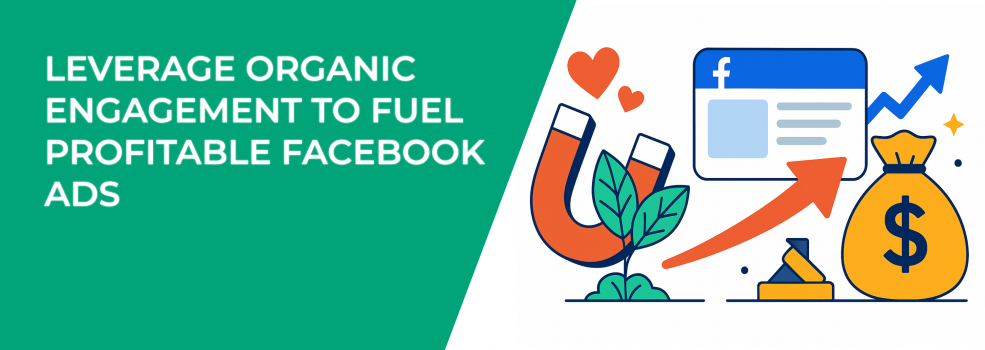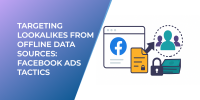Every Facebook advertiser wants better returns. But too often, ad strategies are built in a vacuum — disconnected from the real conversations, reactions, and momentum happening on your organic content. That’s a missed opportunity.
If you’re already investing time in creating content for your Facebook group or a page, why not use that organic engagement as a launchpad for more profitable ads?
Let’s explore how to make that happen and why it works.
Why organic engagement still matters
Yes, Facebook’s algorithm prioritizes paid placements — but that doesn’t mean organic content is irrelevant. On the contrary, high-performing organic posts are some of your best indicators of what really resonates with your audience.
When a post naturally gains likes, shares, or thoughtful comments, it’s telling you something. Maybe the message hits an emotional nerve. Maybe the visuals stop the scroll. Or maybe the timing, tone, or topic is right on target. Organic engagement gives you unfiltered feedback straight from the people who matter.
So why ignore that data when planning your ads?
Smart advertisers watch what works organically, then double down with paid promotion. It’s a simple shift in approach, but it can dramatically improve your return on ad spend (ROAS).
Turn engagement into a signal, not just a metric
Think of organic reactions as signals — not vanity metrics.
A video that sparks a heated debate in the comments could be your next thought-leadership ad. A carousel post with unusually high shares might be your blueprint for a conversion-focused retargeting campaign. When you stop treating organic content and paid campaigns as separate silos, things start clicking.
Here’s how to read the signals:
-
Comments show emotional response — positive or negative. Don’t just look at the number. Read them.
-
Shares indicate content that people want others to see. That’s viral potential.
-
Saves (on Instagram especially) suggest content that’s useful, valuable, or inspiring.
-
Dwell time — how long someone lingers on a post or watches a video — is gold. Facebook tracks this, even if there’s no like or comment.
The key is to look beyond surface-level reactions and dig into what’s causing the engagement. Then, amplify that insight through your ads.
Boost content that's already winning
One of the simplest, yet most underused, tactics in Facebook advertising is boosting your top organic posts.
Not boosting every post. Just the ones that prove they can hold attention and spark interest.
Instead of creating a brand-new ad from scratch, find a post that already performed well and give it a budget. You’ve already tested it in the wild. Why not build on that?
Here are a few things to watch for when choosing which posts to boost:
-
Does it align with your business goal? (Brand awareness, traffic, sales?)
-
Is it evergreen or at least seasonally relevant?
-
Does the post reflect your product/service value clearly?
-
Are the comments mostly positive — or at least civil?
When you find a post that checks those boxes and already has solid engagement, you're halfway to a high-performing ad.
Bonus tip: When boosting, use Engagement Custom Audiences to build remarketing lists from people who interacted with the post. It’s a low-friction way to warm up a cold audience.
Build lookalike audiences from engaged users
Organic engagement isn’t just about reusing content — it’s also a powerful source of high-quality audience data.
You can create Lookalike Audiences from:
-
People who’ve engaged with your Facebook Page,
-
Viewers of your Instagram Reels,
-
Users who messaged your brand,
-
People who saved your posts or videos.
These users already showed interest. Facebook's algorithms can analyze their behavior and demographics, then find similar people who haven’t discovered you yet. That means you're targeting cold audiences that act like warm ones — and that often lowers cost per click and cost per conversion.
Not sure where to start? Try building a 1% Lookalike from your top 25% video viewers or post engagers. Then layer in interest or demographic filters if needed.
Here's also a breakdown of what works best for different types of campaigns if you want more tips.
Go from engagement to conversation
Most advertisers think the job is done when the post goes live. But in reality, that’s when the real opportunity begins.
A comment isn’t just feedback. It’s a window into your audience’s thoughts — and a chance to build something lasting. Whether it’s curiosity, confusion, excitement, or even skepticism, any kind of response signals attention. And attention is currency on social.
So, what should you do with it?
Reply fast. Speed matters. If someone asks a question about your product, service, or offer and you respond within a few minutes, you’re already ahead of 90% of businesses. You’ve created a real interaction, not just a transaction. And that builds affinity.
Turn the thread into a micro-conversion funnel. Let’s say a user comments, “How long is the trial?” That’s your opening. A well-timed reply like, “You can try it free for 14 days — want me to DM you the signup link?” does more than inform. It invites action. Publicly. And others will see it too.
Handle objections head-on. Maybe someone comments, “Too expensive” or “I’ve tried this before, didn’t work.” Most brands ignore or delete these. Don’t. Engage instead. Clarify. Educate. Be human. You’re not just helping that one commenter — you’re reframing perception for everyone watching from the sidelines.
Mine your comments for content gold. What words do customers keep repeating? What are they confused about? What excites them? These raw insights often outperform what you brainstorm in strategy meetings. Screenshot testimonials, turn questions into FAQs, and use objections as inspiration for ad hooks. Your next winning headline may already be sitting in the replies.
This kind of comment-level engagement doesn’t scale easily, and that’s why it works. The effort stands out. And when it’s authentic, it doesn’t just increase conversions — it builds community.
Organic + Paid = Success
The smartest Facebook advertisers don’t separate their content into two buckets: one for engagement, one for ads. They treat it as a single system where momentum from one fuels the other.
Here’s what that looks like in practice. You publish an organic post that taps into something timely or emotionally relevant. Maybe it’s a behind-the-scenes look at your production process, a before-and-after customer result, or a simple but striking product demo. You notice it’s getting higher-than-usual engagement — shares, saves, thoughtful comments. That’s your trigger.
This simple flywheel shows how organic content turns into ads — starting with a post, then boosting it, retargeting, building lookalikes, and repeating
You boost it with a modest budget — not because you have to, but because the data says it’s working already. Now the post reaches people outside your existing base, picking up fresh reactions and visibility. This new engagement gives you the raw material to build a Custom Audience of video viewers, post engagers, or Page followers.
From that audience, you launch a retargeting campaign — maybe with a more direct value proposition or a clear CTA. These people are already familiar with you, so conversions often come easier and at a lower cost.
Then, you use the data from that retargeting success to build a Lookalike Audience and bring even more new people into the top of the funnel.
The result? A repeating cycle of:
-
Low-cost engagement discovery,
-
Paid amplification of what’s proven to work,
-
Retargeting of high-intent users,
-
Expansion through algorithmic targeting.
And you don’t burn out your audience or your budget doing it. Each step is guided by signal, not guesswork.
The magic happens when organic creativity and paid precision work together, and it all starts by simply paying attention to what your audience engages.
For small businesses especially, this list of smart engagement strategies can help boost your content’s reach before you even spend on ads.
Don’t just chase performance — build trust
Chasing clicks can get you traffic. But building trust? That’s what gets you loyalty — and long-term profitability.
In an era where people scroll past hundreds of ads daily, the ones that stop them aren’t the loudest. They’re the ones that feel real. Posts that speak to them like a friend would. Messages that feel like part of the feed — not an intrusion into it.
So if your organic content is consistently playful, casual, and community-oriented, but your ads are overly polished, jargon-heavy, or salesy, you’re creating friction. You’re introducing doubt.
Consistency across touchpoints makes your brand feel intentional. It shows that you know who you are, and that reassures people. It gives them a reason to trust what you say and what you sell.
What’s more, trust-based content outperforms purely promotional content over time. Why? Because people are more likely to engage, comment, and share when something doesn’t feel like an ad. That extra engagement boosts your relevance score and drops your CPC.
So as you’re designing your next paid campaign, revisit your organic content archive. Ask yourself:
-
Which posts started conversations?
-
Which visuals or tones led to genuine DMs or shares?
-
What topics made people tag a friend or ask a question?
Then, don’t reinvent: repurpose, expand, turn those proven trust-builders into ads that scale.
And remember: you're not just targeting an audience. You're speaking to individual humans who want to feel seen. When your paid campaigns reflect what they already love from you organically, the response isn’t just a click — it's connection.
To sharpen your messaging and make your paid ads more engaging, study the psychological drivers that hook audiences fast.
Final thoughts
The divide between organic and paid is an illusion. It’s all part of the same conversation.
When you let organic engagement guide your ad strategy, you spend smarter. You reduce guesswork. You build deeper connections and you sell more, too.
Curious what kind of organic content your audience really connects with? Take a closer look at your past 30 posts and see where that takes you.

